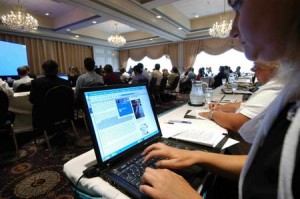Jul 28th, 2009 by Frank LaBanca, Ed.D.

NOTE: I FOUND THIS POST BURIED IN “DRAFT” FORM, NEVER PUBLISHED. HERE IT IS . . .
The continued impact of Web 2.0 “the read-write web” continues to have a profound impact on instructional practices. I have commented about how educators need to reconfigure their teaching approaches and decided to try a new (for me) strategy at a recent presentation I did. I was presenting some of my research about categorizing science fair projects based on the nature of the data and outcome. This was a combined session platform presentation – basically a lecture to an audience. In this format, the audience is expected to be passive in learning style. They listen, consider, and at the end, after the presenter has finished, perhaps ask a few questions.
When considering the nature of socially constructing knowledge, this is probably not a great learning strategy. Individuals need to interact, think, and assimilate ideas. But how can this be done in a traditional format, where I am expected to be a “sage-on-the-stage” instead of a “guide-on-the-side”?
One possible solution, which I’ve heard about, but never tried: creating a backchannel. In essence, a backchannel is a chat room that exists while the presentation is progressing. Participants can comment, interact with one another, form opinions, and ideas, without interrupting the presentation. I downloaded a freeware version of a chat room to my website and put it in a subdomain. The chat can be found at http://chat.labanca.net.
Since this was a trial for me, I haven’t worked out all of the software kinks yet. For example, I don’t have a nice skin on the chatroom yet. I’m not sure how to archive the chat so I can actually read the content after the presentation. (I realized this when I went back and found the discussion missing, and just the later portion was present.
During the second session given by one of my esteemed colleagues Dr. Lori Kolbusz, I suggested we continue to backchannel and actually was a participating member of the chat. Here’s a small sample of the discussion based on Lori’s qualitative research:
02/05/2009 07:46:39 ‹guest385› All, I can’t get over how often social learning theory (Vygotsky, Situated Cogntion) really seems to embed so much good research
02/05/2009 07:47:53 ‹guest276› I am sure Vygotsky was cited in all of the past dissertations at WCSU. What a wealth of knowledge!
02/05/2009 07:48:27 ‹guest89› Vygotsky’s Proximal Zone of Development is something that I can really relate to!
02/05/2009 07:49:22 ‹guest385› The 24-hour cable news cycle doesn’t help the cause of these aberrant events which become the perception of education as a whole
02/05/2009 07:49:55 ‹guest276› I am sure we all agree that no matter whatever district you are in, clear expectations need to be established.
02/05/2009 07:50:01 ‹guest276› and consistency
02/05/2009 07:53:43 * guest15 joins My room
02/05/2009 07:55:30 ‹guest89› It is interesting to note that Vygotsky’s research was conducted in the Stalinistic Era; I am interested in finding out how he kept a lot of his work outside the scope of a totalitarian set of controls – largely through state-mandated regimentation of universities.
02/05/2009 07:55:46 ‹guest385› This is a great sample size for a qualitative study (survey=30); (SSinterviews=10)
02/05/2009 07:57:58 ‹guest89› Agree with you, guest 385. Lorraine mentioned a relevant term; the geberation of “thick data.”
02/05/2009 07:59:41 ‹guest276› With a larger sample size, emergent themes are more likely to arise. I wonder how many she asked before arriving at n=30.
02/05/2009 08:00:10 ‹guest385› It might be possible that she achieved data saturation – would be a good question
02/05/2009 08:01:29 ‹guest15› A little Glasser training would help
02/05/2009 08:02:35 ‹guest276› To be perfectly honest, I don’t think this school district can afford Glasser. What can they do now?
02/05/2009 08:06:10 ‹guest276› 22 paired responses is a pretty good number. Analyzing qual data takes a lot of time. I am thinking of what was analyzed for this study with the 4 RQ’s.
What meaningful comments! This certainly allows for a more active role for the participants. When educators talk about 1-to-1 laptop initiatives, they need to think about this type of reconfiguring, not the “extract the data from the Internet as a consumer” or “type my reports using Word” mentalities. This is a way to use technology to allow learning that can’t take place without. Our students are already doing it anyway. I can’t tell you the number of times I’ve seen students texting. Why not make it more mainstream – and have a way for the teacher to get feedback?
A bit more sophisticated than passing notes under the table!